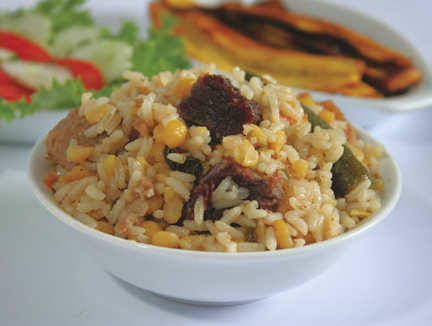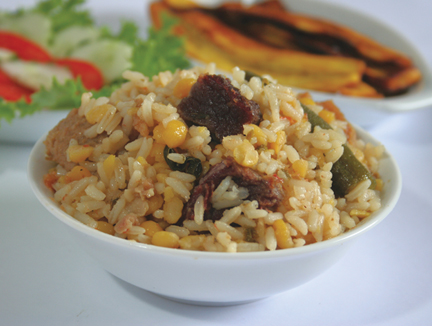Hi Everyone, Yes, it’s a one-pot dish, yes, it’s about everything cooking up together, but no, not all cook-up rice is created equal. The main ingredients that make up a cook-up rice – the peas, the meats and the rice – are themselves not created equal and then of course, each of us will make the cook-up rice to suit our own tastes.
This past week I received an email from a friend and regular reader of this column with some cook-up rice related questions and that prompted me to discuss with you the nuances of this deceptively simple national dish. Cook-up rice is a dish I find that is truly representative of our multi-cultural make-up.

The problem most people have when making cook-up rice has to do with the rice. They complain that either the rice is too soft and therefore sticks together (Barbadians have a good phrase to describe this, they say the rice is too friendly), or the rice is too wet, they were never able to reduce the liquid enough and thus they are unable to have the rice dry but loose. Another problem that is frequently encountered with cooking the cook-up rice is that the rice looks cooked on the outside, but when eaten, it is grainy on the inside. Finally, there are also problems associated with cooking the peas. Some folks complain that the peas melt, especially when cooking split-peas cook-up and this results in the dish being paste-like and always burnt too much at the bottom.
Let’s start with the first problem – rice is too soft. There are two possible explanations for this: too much liquid has been added to the pot or the rice has been added too early to the pot resulting in a longer cooking time.
Second problem– the dish is too wet. One explanation: too much liquid has been added to the pot, all the ingredients are cooked but so as not to overcook them, the cook-up is left wet and served as is.
Third problem – rice is still grainy though it looks cooked. Explanation: the heat was not properly adjusted to cook the dish.
Fourth problem – peas (particularly split-peas) melt and turn into a paste. Explanation: the peas have been added too early to the pot.
I am not going to tell you how to make cook-up rice (though you can email me for my own recipe), what I am going to do is point out certain things for you to consider the next time you are setting out to make a delicious pot of cook-up rice.
The peas – always try to use dried peas that need to be hydrated by soaking overnight. As I stated in last week’s column when I wrote about the channa, the dried peas are much more flavourful and offer better taste and texture.
In terms of cooking times, fresh pigeon peas cook up the fastest; it cooks in the same amount of time as the rice does. Split-peas need a 7 – 10 minute start before adding the rice. Black-eyed peas need a 15 – 18 minute start before the rice. Dried pigeon peas and red kidney beans take the longest to cook and need at least 30 minutes in a pressure cooker, longer if boiling and without the use of a pressure cooker.
The meats – salted meats should be soaked in hot water overnight, if possible, and then boiled for at least for 20 minutes. Doing this will prevent the dish from being salty. Fresh meats such as beef, pork or chicken, should be lightly seasoned with salt and pepper and pan-seared on high heat to bring out their flavour and add some colour so that they do not look and taste bland in the dish. Fresh meat should also be at least half-cooked before the rice is added. The meat will finish cooking in the time the rice takes to cook and all the liquid in the dish absorbed. Remember that beef is a tougher meat and needs a longer cooking time. The pork also needs a little longer cooking time than does the chicken.
Tripe should always be the ingredient to be cooked first and thoroughly because it is the toughest and takes the longest to cook. Also, overcooking the tripe does not result in its disintegration as would be the case with the other fresh meats. Tripe should be pressured for at least 35 – 40 minutes.
The rice and liquid (coconut milk) – each variety of rice requires a different amount of liquid to cook it. Parboiled rice I’ve found stands up best in a cook-up rice. Though it requires more liquid and a longer cooking time, it does not easily get too soft and lose its form. The ratio of liquid for this rice is: 1 cup rice to 2 cups liquid. (The brown rice I see in Guyana is similar to the parboiled rice)
Long grain white rice and Jasmine rice cook very quickly. 1 cup rice to 1 1/3 cups liquid works well here.
Basmati rice: 1 cup rice to 1 ½ cups liquid
Brown rice: 1 cup rice to 3 cups liquid
Now, when to add the milk to the cook-up rice is a matter of personal preference. Some people like to cook the meats and peas with the coconut milk before adding the rice. This way, they would then add water along with the rice to finish cooking the dish. That’s fine, do what you are most comfortable doing. Personally, I cook the meats and peas with just enough water to cook through and then add the coconut milk the same time with the rice, that way everything gets cooked together with the coconut milk.
The seasonings – onions, green onions (eschallots), thyme, whole hot peppers, sweet basil and tomatoes (optional) are the flavourings I find that work well with a cook-up.
And finally, here is a suggested order for making the cook-up rice using the following ingredients: split-peas, tripe, salt-beef and pig-tail. The rice: Long grain parboiled
Sauté onions with thyme and then add the tripe
Pressure the tripe for 35 minutes
Add the salt beef and pigtail to the tripe and pressure for 15 – 20 minutes
Add the split peas to the pot and cook with the other ingredients for about 7 minutes (do not pressure!)
Add the coconut milk, washed rice and other seasonings to the pot with salt and pepper to taste
Bring to a boil covered and then when you start the top of the rice and other ingredients (the liquid would have reduced some), turn the heat to low or simmer and let cook covered for 25 – 30 minutes or until all the liquid has been absorbed.
Feel free to email me for a detailed recipe. And I’d love to hear how you make your cook-up rice.






